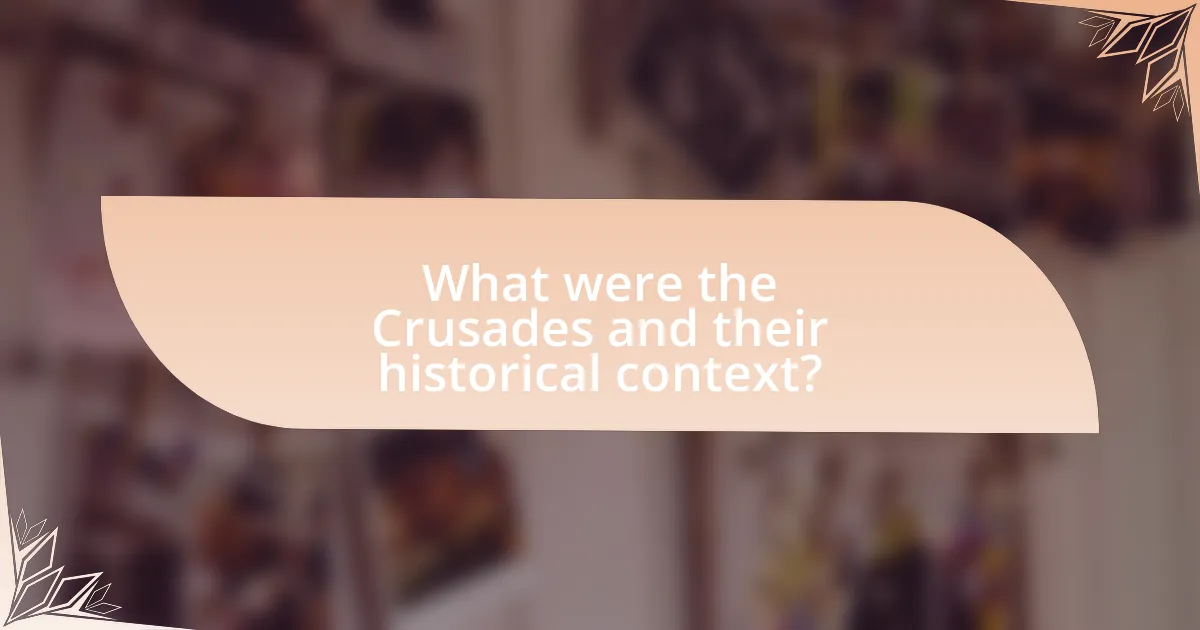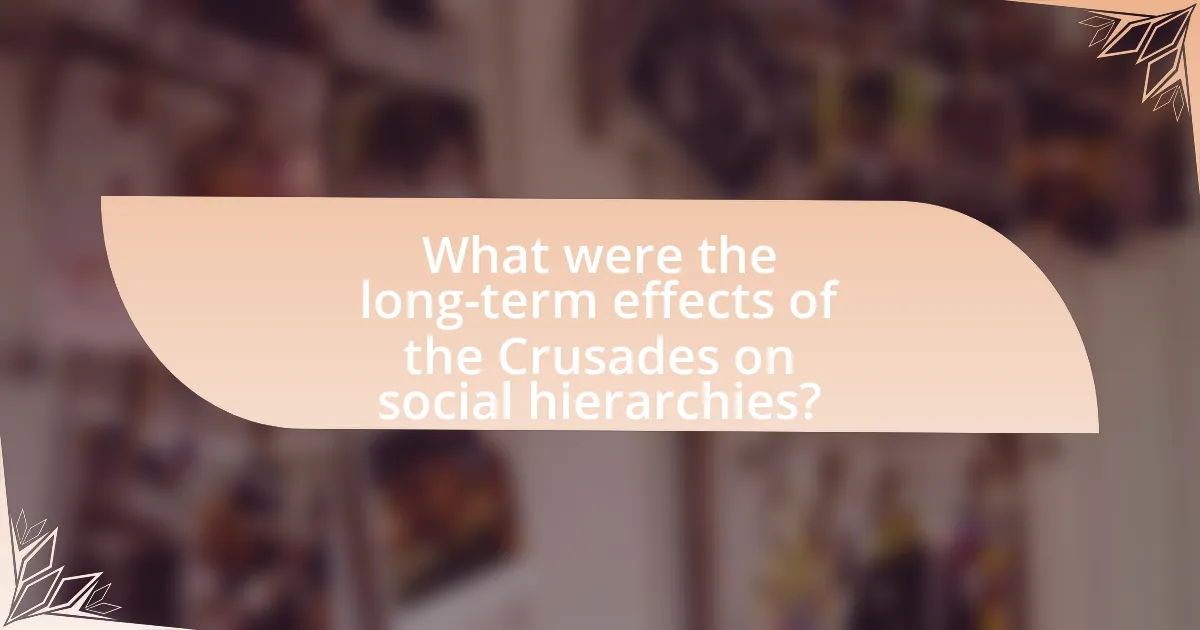The main entity of the article is the impact of the Crusades on social hierarchies in Europe. The article provides a comprehensive overview of the Crusades, detailing their historical context, motivations, and key events, including the First through Fifth Crusades. It examines how these religious wars altered social structures by diminishing the power of feudal nobility, fostering the rise of a merchant class, and transforming economic and political dynamics. Additionally, the article discusses the long-term consequences of the Crusades on social hierarchies, the emergence of new social classes, and the implications for contemporary society, emphasizing the lasting influence of these historical events on modern social dynamics.

What were the Crusades and their historical context?
The Crusades were a series of religious wars initiated by European Christians from the late 11th to the late 13th centuries, primarily aimed at reclaiming Jerusalem and other holy sites from Muslim control. The historical context of the Crusades includes the rise of Islamic empires, the expansion of Christian kingdoms in Europe, and the socio-political dynamics of the time, such as the desire for land, wealth, and the spread of Christianity. The First Crusade, launched in 1096, was particularly significant as it resulted in the capture of Jerusalem in 1099, establishing a Christian presence in the region. Subsequent Crusades, including the Second and Third, reflected ongoing conflicts and shifting alliances, ultimately influencing European social hierarchies by altering trade routes, fostering cultural exchanges, and impacting feudal structures.
How did the Crusades begin and what were their main objectives?
The Crusades began in 1095 when Pope Urban II called for a military expedition to reclaim Jerusalem and the Holy Land from Muslim control. The main objectives of the Crusades included the recovery of sacred Christian sites, the defense of Byzantine Christians against Muslim expansion, and the promotion of Christian unity and piety among European Christians. The First Crusade, initiated by this call, resulted in the capture of Jerusalem in 1099, demonstrating the religious fervor and political motivations that characterized the Crusades.
What were the key events that led to the initiation of the Crusades?
The key events that led to the initiation of the Crusades include Pope Urban II’s call for a military expedition in 1095, which was prompted by the Byzantine Emperor Alexios I Komnenos’ request for help against Muslim advances. Urban II’s speech at the Council of Clermont inspired thousands to take up the cross, framing the campaign as a holy war to reclaim Jerusalem and aid fellow Christians. This call was further fueled by the growing tensions between Christians and Muslims over control of sacred sites in the Holy Land, particularly Jerusalem, which had significant religious importance for both faiths. The combination of religious fervor, political motivations, and the desire for land and wealth among European nobles catalyzed the mobilization for the First Crusade, marking the beginning of a series of religious wars known as the Crusades.
What were the religious and political motivations behind the Crusades?
The religious motivations behind the Crusades primarily involved the desire to reclaim Jerusalem and other holy sites from Muslim control, driven by the belief that Christians had a divine right to these locations. The political motivations included the expansion of territorial power and influence for European monarchs, as well as the unification of Christian states against a common enemy, which helped to consolidate their authority. Historical records indicate that Pope Urban II’s call for the First Crusade in 1095 emphasized both the spiritual duty to liberate the Holy Land and the opportunity for knights to gain land and status, illustrating the intertwining of religious fervor and political ambition.
What were the major Crusades and their outcomes?
The major Crusades include the First Crusade (1096-1099), the Second Crusade (1147-1149), the Third Crusade (1189-1192), the Fourth Crusade (1202-1204), and the Fifth Crusade (1217-1221). The First Crusade resulted in the capture of Jerusalem and the establishment of several Crusader states, significantly altering the power dynamics in the region. The Second Crusade ended in failure, failing to recapture the County of Edessa. The Third Crusade, led by Richard the Lionheart, resulted in a treaty that allowed Christian pilgrims access to Jerusalem but did not reclaim the city. The Fourth Crusade diverted from its original goal, leading to the sack of Constantinople, which weakened the Byzantine Empire and shifted trade routes. The Fifth Crusade aimed to capture Egypt but ultimately failed, demonstrating the diminishing effectiveness of Crusader efforts. Each Crusade had profound impacts on social hierarchies, shifting power among European nobility and affecting relations between Christians and Muslims.
How did each Crusade impact European society?
Each Crusade significantly impacted European society by altering social hierarchies, economic structures, and cultural exchanges. The First Crusade (1096-1099) led to the establishment of feudal states in the Levant, which allowed European nobles to gain wealth and land, thereby increasing their power and influence in Europe. The Second Crusade (1147-1149) failed militarily but heightened awareness of the East, fostering trade relationships that benefited merchants and shifted economic power towards urban centers. The Third Crusade (1189-1192) saw the rise of strong monarchies, as leaders like Richard the Lionheart gained prestige, which reinforced the authority of kings over feudal lords. Subsequent Crusades, including the Fourth (1202-1204), further complicated social structures by introducing new classes of merchants and crusaders who returned with wealth and ideas, challenging traditional feudal norms. Overall, the Crusades catalyzed a transformation in European society, leading to the decline of feudalism and the rise of centralized monarchies and urban economies.
What were the consequences of the Crusades on the Middle East?
The consequences of the Crusades on the Middle East included significant political fragmentation, economic disruption, and social changes. The Crusades led to the weakening of Muslim states, as they were forced to respond to the military campaigns of European powers, which resulted in a temporary loss of territory and resources. For instance, the capture of Jerusalem in 1099 by the Crusaders disrupted local governance and altered power dynamics among Muslim leaders. Economically, the influx of European trade and the establishment of Crusader states shifted trade routes and created new economic dependencies. Socially, the Crusades intensified sectarian divisions, as they fostered animosity between Christians and Muslims, leading to long-lasting tensions that affected social hierarchies and community relations in the region.

How did the Crusades influence social hierarchies in Europe?
The Crusades significantly altered social hierarchies in Europe by diminishing the power of the feudal nobility and enhancing the status of the merchant class. As nobles participated in the Crusades, many lost land and wealth, leading to a decline in their influence. Concurrently, the demand for supplies and services during the Crusades bolstered the economic power of merchants, who gained wealth and social standing. This shift is evidenced by the rise of towns and trade networks, which facilitated the emergence of a more prominent middle class, ultimately contributing to the gradual decline of feudalism and the rise of more centralized forms of governance in Europe.
What changes occurred in the feudal system as a result of the Crusades?
The feudal system underwent significant changes as a result of the Crusades, primarily due to the redistribution of land and the rise of a more centralized authority. The Crusades led to the weakening of local lords as many nobles left to fight, which diminished their control over their vassals and lands. This absence allowed monarchs to consolidate power, often reclaiming lands and increasing their authority over the nobility. Additionally, the influx of wealth from the Crusades, particularly through trade and plunder, shifted economic power towards those who supported the monarchy, further altering the feudal hierarchy. Historical records indicate that by the end of the Crusades, many serfs gained greater autonomy, as the demand for labor increased in the absence of lords, leading to a gradual decline in the rigid class structure of feudalism.
How did the Crusades affect the power dynamics between nobles and the monarchy?
The Crusades significantly shifted the power dynamics between nobles and the monarchy by enhancing the authority of kings while diminishing the influence of feudal lords. As nobles participated in the Crusades, they often left their lands and vassals behind, which allowed monarchs to consolidate power and assert greater control over territories. For instance, the absence of many nobles during the Crusades led to a temporary weakening of feudal obligations, enabling kings to reclaim lands and increase their revenues. Additionally, the financial burdens of the Crusades compelled monarchs to levy taxes and seek new sources of income, further centralizing authority. This shift is evidenced by the rise of royal power in England and France during the late 12th and early 13th centuries, as kings like Richard the Lionheart and Philip II utilized the Crusades to strengthen their positions against the nobility.
What role did the Crusades play in the rise of the merchant class?
The Crusades significantly contributed to the rise of the merchant class by expanding trade routes and increasing demand for goods. As European armies traveled to the Holy Land, they encountered new markets and products, which stimulated interest in trade with the East. This interaction led to the establishment of trade networks, particularly in cities like Venice and Genoa, where merchants capitalized on the influx of goods such as spices, silk, and precious metals. The increased wealth generated from these trade activities allowed merchants to gain social status and influence, ultimately transforming them into a powerful economic class within European society.
How did the Crusades impact the status of the clergy and religious institutions?
The Crusades significantly elevated the status of the clergy and religious institutions. As the Church played a central role in promoting and organizing the Crusades, it gained increased authority and influence over both spiritual and temporal matters. The mobilization of resources for the Crusades led to the accumulation of wealth and land for religious institutions, enhancing their economic power. Additionally, the participation of clergy in military campaigns reinforced their social standing, as they were seen as spiritual leaders guiding the faithful in a holy cause. Historical records indicate that the Church’s involvement in the Crusades solidified its position as a dominant force in medieval society, shaping the relationship between religion and governance during that period.
What changes did the Crusades bring to the Church’s influence in society?
The Crusades significantly increased the Church’s influence in society by enhancing its authority and expanding its reach across Europe. The mobilization of large numbers of people for the Crusades led to the Church becoming a central figure in European politics and society, as it was seen as the driving force behind the military campaigns. Additionally, the Crusades facilitated the Church’s ability to collect taxes and gain land, further solidifying its power. Historical records indicate that the Church gained substantial wealth and resources through donations and the establishment of new religious orders during this period, which allowed it to exert greater control over both spiritual and temporal matters in medieval Europe.
How did the Crusades affect the relationship between different religious groups?
The Crusades significantly strained the relationships between different religious groups, particularly between Christians and Muslims. The military campaigns initiated by European Christians aimed to reclaim the Holy Land from Muslim control, leading to widespread violence and hostility. This period saw the establishment of a narrative that portrayed Muslims as enemies, which fostered deep-seated animosity and mistrust. Historical accounts, such as those by chroniclers like Fulcher of Chartres, illustrate how the Crusaders’ actions, including massacres and forced conversions, exacerbated divisions and created lasting stereotypes. Consequently, the Crusades not only intensified religious conflict but also laid the groundwork for centuries of tension between these groups.

What were the long-term effects of the Crusades on social hierarchies?
The long-term effects of the Crusades on social hierarchies included the weakening of feudalism and the rise of a more centralized authority. As nobles participated in the Crusades, many lost their lands and wealth, leading to a decline in their power. This shift allowed monarchs to consolidate authority, as they could reclaim lands and strengthen their control over territories. Additionally, the Crusades facilitated increased trade and interaction with the East, which contributed to the emergence of a merchant class that gained wealth and influence, further altering traditional social structures. The increased wealth of merchants and the decline of noble power ultimately led to the gradual rise of a more modern social hierarchy based on economic status rather than solely on land ownership.
How did the Crusades contribute to the emergence of new social classes?
The Crusades contributed to the emergence of new social classes by facilitating economic growth and shifting power dynamics in medieval Europe. As nobles and knights participated in the Crusades, they often returned with wealth and land acquired through conquest, which elevated their social status and created a new class of wealthy landowners. Additionally, the increased trade between Europe and the East during the Crusades led to the rise of a merchant class, as merchants capitalized on the demand for goods such as spices and textiles. This economic transformation was significant; for instance, the establishment of trade routes and the influx of wealth contributed to the decline of feudalism and the rise of a more market-oriented economy, ultimately leading to the development of a more complex social structure.
What were the implications of increased trade and wealth on social structures?
Increased trade and wealth during the Crusades led to significant changes in social structures, primarily by fostering the rise of a merchant class and diminishing the power of feudal lords. The influx of goods and wealth from the East created economic opportunities that allowed merchants to gain influence and challenge the traditional aristocracy. For instance, cities like Venice and Genoa became powerful trade hubs, enabling merchants to accumulate wealth and political power, which shifted the social hierarchy. This transformation is evidenced by the establishment of guilds and the increased importance of urban centers, which provided a platform for the emerging bourgeoisie to assert their interests and rights, ultimately contributing to the decline of feudalism and the rise of more centralized forms of governance.
How did the Crusades influence the development of towns and urban centers?
The Crusades significantly influenced the development of towns and urban centers by stimulating trade and commerce, leading to urbanization. As European crusaders traveled to the Holy Land, they established trade routes and connections with the East, which introduced new goods and ideas to Europe. This influx of trade led to the growth of markets and the establishment of towns around these commercial hubs. For instance, cities like Venice and Genoa became prominent trading centers due to their strategic positions along these routes, facilitating the exchange of spices, textiles, and other commodities. Additionally, the need for logistical support for crusading armies contributed to the rise of urban centers that provided supplies and services, further enhancing their economic importance.
What lessons can be learned from the social changes initiated by the Crusades?
The social changes initiated by the Crusades demonstrate the importance of cross-cultural interactions in reshaping societal structures. The Crusades facilitated the exchange of ideas, goods, and technologies between Europe and the Middle East, leading to the emergence of a more interconnected European society. For instance, the introduction of Eastern goods such as spices and textiles stimulated trade and contributed to the rise of a merchant class, which altered traditional feudal hierarchies. Additionally, the exposure to different cultures and philosophies encouraged a shift in attitudes towards education and knowledge, as seen in the establishment of universities in Europe influenced by Islamic scholarship. These changes highlight how external influences can lead to significant transformations in social hierarchies and economic structures.
How can understanding the impact of the Crusades inform current social dynamics?
Understanding the impact of the Crusades can inform current social dynamics by highlighting the historical roots of inter-religious tensions and social stratification. The Crusades, which spanned from the late 11th to the late 13th centuries, not only intensified the divide between Christianity and Islam but also established patterns of social hierarchy that persist today. For instance, the Crusades contributed to the emergence of a feudal system in Europe, which reinforced class divisions and influenced contemporary social structures. Additionally, the legacy of the Crusades has fostered ongoing cultural narratives that shape perceptions of the “Other,” affecting modern intergroup relations and conflicts. Historical analysis reveals that these dynamics continue to resonate in current geopolitical tensions and social inequalities, illustrating the lasting influence of the Crusades on today’s societal frameworks.
What best practices can be derived from the social transformations of the Crusades?
Best practices derived from the social transformations of the Crusades include fostering intercultural dialogue, promoting social mobility, and encouraging the establishment of diverse communities. The Crusades facilitated interactions between different cultures, leading to the exchange of ideas and practices, which underscores the importance of dialogue in overcoming social barriers. Additionally, the Crusades allowed individuals from lower social classes to gain prominence through military service and trade, highlighting the value of social mobility in creating more equitable societies. The establishment of multicultural communities during this period demonstrates the benefits of diversity in enriching social structures and fostering cooperation among various groups. These practices illustrate how historical social transformations can inform contemporary approaches to building inclusive societies.